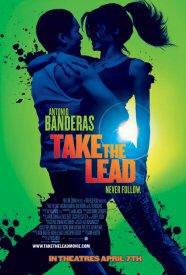|
Take The Lead Reviewed by Rich Drees
Antonio Banderas stars in this cotton candy wisp of a movie as Dulaine, a ballroom dance teacher who volunteers to teach to students serving detention at a New York City high school. At first the students are resistant to the idea but he soon wins them over and they begin training for the inevitable competition that forms the third act of films like this. Along the way, the students have to face a variety of dangers their urban life brings them.
For a
storyline that has been told many times before, Take The Lead
has a number of script problems. The film’s screenplay seems to take
an almost perverse delight in throwing complications at its
characters. Most seem to spring naturally from the various
characters’ situations, though some – like when one character is
propositioned by one of her prostitute mother’s regular johns –
seemed forced in into the story. Another problematic story element
is the math teacher character who is opposed to utilizing school
resources on the dance class. This storyline comes to a head at a
PTA meeting that exists solely so the movie can spell out to any of
the audience who couldn’t figure it out for themselves how the class
is helping the self-esteem of the dancers.
The film also plays fast and loose with its own internal story logic. Early in the film, Dulaine explains to his students why older music is used in ballroom dance. However, his argument is undercut by the film in the very next scene in which Dulaine and one of his longtime students give a demonstration on the sensuality of the tango to music that definitely has hip-hop beats in its mix even though it is only later in the film that Dulaine is shown by his students that traditional music and hip hop can be mixed and used on a ballroom dance floor.
First-time feature director Liz Friedlander does a good job holding the film together as a narrative, but her music video roots betray the movie when it comes to the dance numbers. The music video-style fast editing doesn’t allow the audience to truly watch the teen cast dance. Instead, the fast editing suggests that the filmmakers are trying to hide something or perhaps are trying to inject what little life they can into the proceedings. |
 Take The
Lead
Take The
Lead